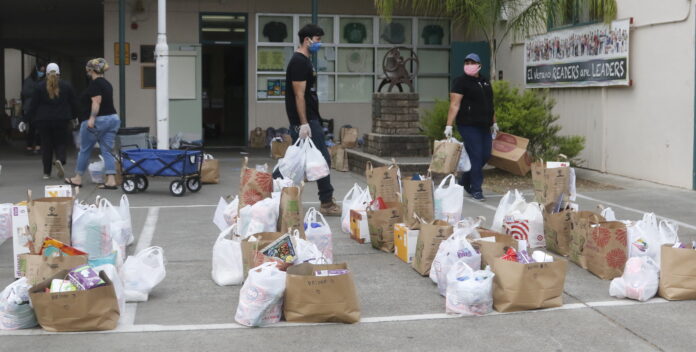In the North Bay, as across the country, the price of doing good is rising.
In 2018, two years before the pandemic, 60,000 Sonoma County households, roughly one third of the total, “couldn’t afford enough food to eat a healthy three meals a day,” according to a February 2020 report prepared by the Sonoma County Hunger Index, a coalition of local nonprofits and government agencies.
Now, two and a half years into the COVID-19 pandemic, North Bay nonprofits big and small are struggling to keep up with demand from residents seeking food and other necessities. The Hunger Index has not released a report since the start of the pandemic, but food banks and other support nonprofits say the massive wave of demand at the start of the pandemic and other disasters never fully subsided.
“We have everyday disasters that are familiar, you know, whether people get injured, unemployed, sick, whatever the issue might be, and then we have these sort of larger scale public disasters, whether they are fires or floods or global pandemics. After each one of these, we have a new baseline… Service never returns to pre-disaster times. Our numbers never went back to pre-pandemic levels in terms of service,” said David Goodman, the executive director of the Redwood Empire Food Bank.
Making matters worse, increases in the costs of food, gas, rent and other necessities over the past two years have impacted struggling residents and the nonprofits attempting to help them.
Price hikes paired with decreased donations, recently led Food For All/Comida para Todos, a volunteer-run group which has offered weekly deliveries of food and other necessities to Sonoma Springs families since April 2020, to make the painful decision to cut back the number of families they serve.
“During the height of the pandemic, it was pretty easy to raise money. That’s no longer the case,” Maite Iturri, one of the group’s members, said. “The demand, and the need, for food has only increased, and our food costs have dramatically increased. So much so that we’ve had to cut back the number of people we’re serving [to 100 families from an average of 140].”
Iturri thinks that inflation and financial uncertainty may have slowed donations. However, another factor is the lack of visibility of the ongoing problem. At the start of the pandemic, swelling food lines drew news coverage. But, now that pandemic-era economic supports have tapered off and politicians have declared the worst of the pandemic over, the world is “back to business as usual,” and hunger has become less visible.
“Our hashtag right now is ‘It’s not over,’” Iturri said.
Food For Thought Food Bank, a Forestville-based nonprofit which serves people living with serious medical conditions throughout the county, is grappling with many of the same issues, according to executive director Ron Karp.
At the start of the pandemic, Food For Thought received significant donations from foundations and individuals—including some who handed over their stimulus checks—but those one-time contributions have fallen off, despite persistent demand. The food bank has served about 6,000 individuals per year since the start of the pandemic, up from 1,100 in 2019.
Meanwhile, costs have gone up across the board, Karp said. Increased food prices and gas prices make deliveries and operations costs more expensive. The nonprofit is even grappling with real estate costs. This year, the food bank’s property insurance premiums skyrocketed 300% due to fire risk adjustments, according to Karp.
“A lot of people were able to recover quickly from COVID or really never had an issue other than being confined at home. But the people at the bottom of the ladder, now that prices and rents have gone up—you know, rents have gone up way faster than inflation—it’s just making it really hard for people,” Karp said.
While the pandemic-era benefits like the Child Tax Credit, boosted unemployment benefits and stimulus payments reportedly temporarily lifted millions of families and children out of poverty, the definition of “poverty” itself is woefully out of date.
In 2020, the federal government defined “poverty” as a family of four making less than $26,200 per year.
However, the amount of money needed to get by comfortably, even before inflation worsened things, was much more. The living wage—the amount of money needed to support an individual or family in Sonoma County—is $128,336 per year for two working parents supporting two children, according to the MIT Living Wage Calculator. (In 2021, the average median wage for an individual was $40,531, much lower than the cost of living, according to the 2021 Portrait of Sonoma County report.)
Searching for a silver lining, Goodman said that the pandemic and other disasters may help with the “generation of empathy, where people just realize that ‘that’s me.’ ‘That could be me.’ And ‘why it’s not me is almost just dumb luck.’”
“We serve people that have nothing all the way up to people who are gainfully employed and are just struggling,” Goodman said.
Support Network
If you have the resources and would like to support someone in need by contributing or volunteering, contact one of the following nonprofits working on food access on this (incomplete) list:
Ceres Community Project (ceresproject.org)
Community Action Napa Valley (canv.org/emergency-food-pantry)
F.I.S.H. (Friends In Service Here) of Santa Rosa (fish-of-santa-rosa.org)
Food For All/Comida para Todos (foodforallsonoma.org)
Food For Thought Food Bank (fftfoodbank.org)
Petaluma Bounty (petalumabounty.org)
Redwood Empire Food Bank (refb.org)
San Francisco-Marin Food Bank (sfmfoodbank.org)
Sonoma Acts of Kindness (socoactsofkindness.org)











